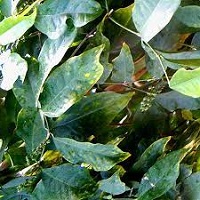Okazi Leaf: Health Benefits and Side Effects of Ukazi leaves
Okazi Leaf: Health Benefits and Side Effects of Ukazi leaves

Afang leaf/Ukazi leaf and Pregnancy, Ukazi and Pregnancy, health benefits of okazi leaf, benefits of Gnetum africanum, health benefits of Eru leaves, Medicinal uses of Gnetum africanum, health.
Table of Contents
Okazi Leaf Common names (tribes/languages) include:
- Ukazi leaf (Igbo)
- okazi leaf (Igbo)
- Afang leaf (ibibio/akwa Ibom)
- Ukase
- Eru
- Okok
- m’fumbua, or fumbua
- African Jointfir
- Gnetum africanum (botanical name).
- Wild spinach (What is ukazi leaf called in English – Wild Spinach)
- Yoruba name for ukazi leaf? I don’t know, do you know? If yes, please let me know so I can update accordingly. Thank you
What is okazi leaf?
The okazi leaves are strong (hard) and glossy and resemble orange tree leaves. It doesn’t have a distinct smell, but it does have a slightly bitter taste.
Okazi/Ukazi/Afang Leaf (Gnetum Africanum) is used for preparing Nigerian Afang soup and Okazi/Ukazi leaf Soup.
An Overview of Gnetum Africanum (Okazi Leaf)
Gnetum Africanum, often known as okazi or afang leaf, is a climbing leafy vegetable belonging to the Gnetaceae family.
The tropical regions of Nigeria, Congo, Gabon, Angola, Asia, and South America are all home to this greenish climbing shrub. Gnetum buchholzianum and Gnetum Africanum are the two primary species found in Africa.
How to grow ukazi leaves – how to plant okazi leaf
The okazi vine is a non-seasonal perennial plant that can grow as new shoots or as a rhizome from a part of the stem that has been taken out.
When the okazi, eru, or afang vine reaches maturity, it produces tiny blooms, and the seeds resemble drupe fruits, measuring 4–8 mm x 10–15 mm in size.
Characteristics of Okazi Leaves
The okazi is known for its thick, papery-like leaves that are difficult to cut.
The leaf of Gnetum Africanum can be used as a cure for a variety of maladies and disorders due to its antioxidant, anti-inflammatory, and anticarcinogenic characteristics.
While the Western world refers to okazi leaf as wild spinach or wild vegetable, different African countries have different names for it, for example, the Congolese call it fumbua, KoKo, Nigerians call it afang, okazi, ukazi, and Cameroonians call it okok, m’fumbua, or fumbua, eru.
Okazi leaf uses
The edible leaves are frequently sliced into short strips and used in a variety of cuisines and recipes, such as stews and soups;
Nigerians, for example, use the leaf to make vegetable or edikang Ikong soup, egusi soup, and other dishes among others.
The afang plant is not commonly grown as a garden plant, but rather as a forest vine whose leaves are harvested for culinary and medicinal purposes.
Aspartic acid, dietary fiber, cysleine, protein, vitamins, sodium, magnesium, calcium, iron, zinc, manganese, potassium, copper, glutamic acid, leucine, and vital amino acids are all abundant in ukazi leaf.
Africanum’s relatively high protein content explains why it includes a significant amount of necessary acids that can serve as an alternate energy source, particularly when carbohydrate metabolism is disrupted by glucogenesis.
Okazi Soup
Ukazi and afang soup are the same things. It’s known as Afang Igbo in Akwa Ibom and ukazi in Igbo. Dry fish, crayfish, ugu, and Achara are all good options.
The okazi leaves can be purchased fresh or dried, and both are suitable for this soup.
If you’re using dry okazi, add it early in the cooking process to allow it to rehydrate and soften.
In Efik or Ibibio, okazi is known as “Afang” and is used to make Afang soup.
Is Ofe Owerri and Ofe Okazi Same?
Ofe Owerri is similar to Ofe oKazi, except Ofe Owerri is thickened with cocoyam, whereas Ofe Okazi is thickened with achi, ukpo, or ofo. Each thickener has its own distinct taste.
Benefits of Okazi Leaf
Aspartic acid, fiber, cysteine, proline, vitamins, sodium, magnesium, calcium, iron, zinc, potassium, copper, and many other nutrients can be found in the leaf.
ukazi leaf can be used as a cure for some disorders due to its antioxidant and anticarcinogenic effects.
Ukazi Leaf Health Benefits
The treatment of enlarged spleens, sore throats, and nausea are among the potential health advantages of okazi leaf (afang). Okazi also relieves constipation and aids in the regulation of blood sugar levels in diabetics.
19 Health Benefits of Okazi leaf
The possible okazi leaf health benefits comprise the treatment of sore throats, enlarged spleens, and nausea.
Okazi also eases constipation and assists to control blood sugar levels in people with diabetes.
- Helps in the development of strong bones and teeth. Aids fight osteoporosis.
- Reduces blood pressure.
- Include the leaf in your meal plan. Ukazi helps in weight loss.
- Because of its high fiber content, ukazi is a good laxative and helps treat constipation.
- It has anti-inflammatory properties
- Helps treat anemia and to boost blood production and packed cell volume.
- Reduces blood sugar in diabetic patients.
- Ukazi leaves have been used traditionally in the treatment of sore throat.
- Is also used in the treatment of nausea and vomiting.
- Gnetum Africanum stem can be eaten raw which helps in reducing childbirth pain as well as menstrual pain.
- Aside from the leaves, the okazi tuber and seeds can be cooked and eaten as food.
- The seeds and the leaves of Gnetum Africanum together have been proven to be medically efficient for treating enlarged spleen.
- The cut pedicles are crushed and mixed with soap, then used for washing the hair in other to stimulate hair growth.
- Researchers claim that the okazi vine is high in iodine.
- The seeds can be chewed raw and used for controlling excessive urination.
- Okazi Leaf serves as an antidote for poisons.
- Traditionalists utilize the okazi leaf for preparing medicines used in the treatment of children suffering from measles.
- The seeds of the Gnetum africanum can also be used as fungicides for dressing wounds.
Even the G. africanum bark can be used for producing fishing nets and rope.
Consuming ukazi often lowers the risk of cardiovascular disease and coronary heart diseases, and aids to slow the progression of heart disease in individuals who have cardiac diseases
Ukazi promotes fertility
Okazi leaf promotes sexual desire and ovulation in females and penile erection and libido in males by increasing blood flow to the sexual organs.
Okazi Leaf and Pregnancy – Is Ukazi safe in pregnancy?
Yes, it is correct. Foods prepared with Ukazi and soups are safe for pregnant women to eat. They don’t have to be concerned.
Early morning sickness, such as vomiting, can be avoided with the use of afang leaf throughout pregnancy.
There have been no reports of okazi leaf causing birth abnormalities or miscarriage in women.
There have been no reports of Afang leaf causing birth abnormalities, miscarriage, or pregnancy loss in women. Enjoy.
Ukazi does NOT shrink fibroids.
Is there a difference between Ukazi and Utazi? Is Ukazi same as Utazi?
Ukazi is a slender and robust vegetable that is commonly used in afang soup but can also be used alone or in combination with other vegetables in other soups.
While Utazi is primarily used for pepper soup, it may also be used for oil bean salad and tapioca.
I prefer it crushed and put in a red oil yam sauce. It has a bitter-sweet flavor to it.
Okazi leaf in English – what is the okazi leaf called in English
Wild spinach
While okazi leaf is known as wild spinach or a wild vegetable in the West, it is known by many various names in Africa.
For instance, the Congolese call it fumbua, KoKo; Nigerians call it afang, okazi, and ukazi; and Cameroonians call it okok, m’fumbua, or fumbua, eru.
What are the Okazi Leaf’s health advantages? What are the health benefits of Okazi Leaf?
Okazi leaf (afang) may be used to alleviate nausea, sore throats, and enlarged spleens among other conditions. Additionally, okazi helps persons with diabetes manage their blood sugar levels and relieves constipation.
What is the English name of afang leaf?
The English term “wild spinach” has also been used to describe Gnetum africanum.
It is a leafy green vegetable that is used to make a variety of dishes in Nigeria and other African nations like the Congo, Gabon, and Angola as well as in Asia and South America.
Is afang leaf Okazi Leaf?
Afang or Okazi leaf is a common ingredient in the Southern region of Nigeria’s Afang Soup. It is a dark green, leafy vegetable with a mildly bitter flavor. In English, it is referred to as Wild Spinach.
What is the scientific name of Okazi?
Okazi or afang leaf, botanically known as Gnetum Africanum is a climbing leafy vegetable that is a member of the Gnetaceae family. In particular, Nigeria, Congo, Gabon, Angola, Asia, and South America are home to large populations of this emerald-green climbing shrub.
What are leaves from Okazi? Okazi leaves meaning? What is okazi leaf?
The okazi leaf, commonly referred to as wild spinach, has a little bitter taste.
This leafy green vegetable is a common ingredient in South American and African cuisine, particularly in Nigerian afang soups.
The Efik and Ibibio people are known for their love of afang soup. It contains a lot of beef, lush green veggies, and palm oil.
Can a pregnant woman eat Okazi Leaf?
It is, indeed. Soups and cuisine prepared with ukazi are safe for pregnant women to eat.
They don’t need to be concerned. Afang leaf aids in preventing pregnancy morning sickness, including vomiting.
What’s the purpose of Okazi? What is Okazi used for?
It is mostly used as a garnish for dishes like African salad (Abacha&Ugba), Isiewu, and Nkwobi, but it is also included in recipes for soups like Nsala and utazi, as well as a special fish and unripe plantain dish for diabetic patients.
I hope this has made it easier for you to tell these common Nigerian vegetables apart.
The spiritual benefit of okazi leaf – What is the benefit of Okazi Leaf?
The health benefits of Okazi are a result of the high antioxidant, vitamins, and mineral content. It can also be used as a treatment for boils, hemorrhoids, and warts.
Additionally, ukazi leaves are used to make teas that reduce labor discomfort and help diabetics maintain proper blood sugar levels.
Is okazi leaf bitter?
Afang soup and Okazi/Ukazi soup are made with the Okazi/Ukazi/Afang Leaf (Gnetum Africanum).
The leaves are glossy and robust, and they resemble orange tree leaves more than anything else. It really lacks a distinctive flavor.
How do you soften Okazi leaves?
Firstly, cook for about 3-5 minutes. Then, pulse the okazi leaves in a blender or food processor with a little bit of water to make them pliable.
After that, repeat the same process with the chopped fresh spinach.
Okazi leaf in Yoruba
Still under search
How to cook okazi and water leaf
Please follow this link to learn how to cook okazi and water leaf soup >>>> https://www.facebook.com/2287443054871714/posts/okazi-and-waterleaf-soup-afang-soupingredientsokazi-leaves-you-may-want-to-buy-t/2552233395059344/
How to plant okazi leaf
I don’t know if the cultivation is domesticated.
You need to go in search of its seedlings in the rural areas. I know that Cameroon does export it to Nigeria, Europe, and North America.
Disclaimer
This article is provided for educational purposes only and should not be used as a substitute for professional diagnosis or treatment.
Always get medical advice from your doctor before making any health-related decisions or seeking counseling, assistance, or treatment for a specific medical problem.


